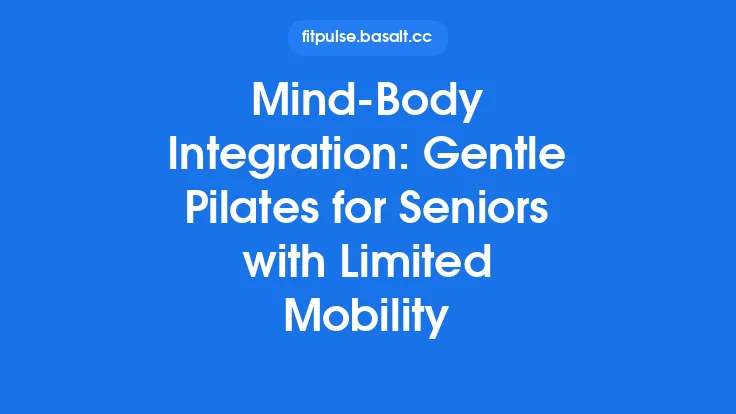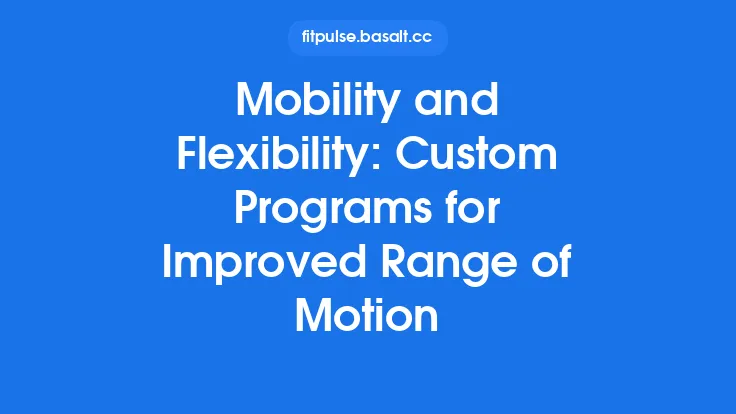Aging brings a unique set of challenges and opportunities for the body. While the natural decline in muscle mass, joint cartilage, and proprioceptive acuity can make everyday movements feel more demanding, seniors also possess a wealth of experience and motivation that can be harnessed to maintain—and even improve—balance and flexibility. A holistic mobility practice goes beyond isolated stretches or balance drills; it weaves together physical, neurological, nutritional, and psychosocial elements to create a resilient, adaptable system. Below is a comprehensive guide to building such a program, grounded in evidence‑based principles and designed for long‑term sustainability.
Understanding the Senior Body: Physiological Shifts That Matter
- Musculoskeletal Changes
- Sarcopenia: Beginning in the fourth decade, muscle fibers gradually atrophy, especially type II (fast‑twitch) fibers, reducing power and reaction speed.
- Joint Cartilage Thinning: Synovial fluid production diminishes, leading to less lubrication and a higher risk of stiffness.
- Connective Tissue Elasticity: Collagen cross‑linking increases, making tendons and ligaments less pliable.
- Neurological Adjustments
- Reduced Proprioceptive Sensitivity: Mechanoreceptors in the skin, muscles, and joints fire less efficiently, compromising the brain’s internal map of body position.
- Slower Central Processing: Reaction times lengthen, affecting the ability to correct balance perturbations quickly.
- Cardiovascular and Respiratory Influences
- Decreased VO₂ Max: Lower aerobic capacity can limit the endurance needed for longer mobility sessions.
- Altered Blood Flow: Peripheral circulation may be reduced, influencing tissue health and recovery.
Understanding these shifts helps tailor interventions that address the root causes of balance loss and reduced range of motion, rather than merely treating symptoms.
Core Principles of a Holistic Mobility Framework
| Principle | Practical Implication |
|---|---|
| Functional Integration | Prioritize movements that mimic daily tasks (e.g., sit‑to‑stand, reaching for a shelf) to reinforce neural pathways used in real life. |
| Progressive Overload with Safety | Gradually increase difficulty (e.g., adding a light weight or reducing base of support) while maintaining a margin of safety to stimulate adaptation without injury. |
| Multisensory Stimulation | Combine visual, vestibular, and somatosensory cues (e.g., eyes closed balance drills on a foam surface) to sharpen proprioception. |
| Mind‑Body Synchrony | Use breath‑guided movement and mindful attention to enhance cortical engagement and reduce fear of falling. |
| Lifestyle Embedding | Integrate mobility work into routine activities—walking the dog, gardening, or cooking—to increase adherence. |
These pillars ensure that each session contributes to a broader, interconnected system rather than isolated skill sets.
Integrating Balance Training into Everyday Life
- Dynamic Stance Variations
- Weight Shifts: While standing in line, practice shifting weight from heel to toe and side‑to‑side, holding each position for 5–10 seconds.
- Single‑Leg Support: During a TV commercial break, lift one foot off the ground, aiming for 15–30 seconds per leg, using a chair for support if needed.
- Perturbation‑Based Drills
- Gentle Nudges: Have a partner lightly push the shoulders forward and backward while the senior maintains an upright posture, encouraging reflexive ankle and hip adjustments.
- Surface Modulation: Walk on a low‑profile foam mat or a carpeted rug for short intervals to challenge ankle stability.
- Functional Reach Exercises
- Forward Reach: From a standing position, extend the arm forward as far as possible without stepping, then return. Perform 8–10 repetitions, alternating arms.
- Lateral Reach: While holding onto a sturdy countertop, reach sideways with the opposite hand, mimicking the motion of retrieving an item from a high shelf.
- Dual‑Task Scenarios
- Combine a simple cognitive task (e.g., counting backward by threes) with a balance activity to train the brain’s ability to allocate resources under real‑world conditions.
These strategies embed balance work seamlessly into daily routines, reducing the perception of “extra” exercise and fostering natural skill retention.
Flexibility Techniques Tailored for Older Adults
- Joint‑Specific Mobilizations
- Hip Capsule Circles: While seated, gently draw circles with the knee, moving through the full range of motion. Perform 5 circles in each direction per side.
- Thoracic Rotation: Sit upright, place one hand behind the head, and rotate the torso toward the opposite side, holding for 2–3 seconds. Repeat 8–10 times per side.
- Myofascial Release with Soft Tools
- Use a lightweight foam roller or a tennis ball to apply slow, sustained pressure (30–60 seconds) on tight areas such as the calves, quadriceps, and upper back. This helps remodel fascial adhesions that limit flexibility.
- Active‑Assisted Stretching
- Wall Slides: Stand with the back against a wall, arms raised to form a “Y” shape, then slide the arms up and down while maintaining contact with the wall. This encourages controlled lengthening of the shoulder girdle.
- Seated Hamstring Stretch: Sit on a chair, extend one leg forward with the heel on the floor, and gently lean forward from the hips, keeping the spine neutral. Hold for 20–30 seconds, repeat 2–3 times per leg.
- Dynamic Stretching Warm‑Ups
- Prior to a mobility session, perform low‑intensity, movement‑based stretches such as leg swings or arm circles for 30–60 seconds each. This raises tissue temperature and primes the nervous system for deeper work.
Flexibility work should be performed at a comfortable intensity—never to the point of sharp pain—to respect the reduced elasticity of aging connective tissue while still promoting range of motion.
Mind‑Body Practices that Enhance Mobility
- Tai Chi: This ancient Chinese martial art emphasizes slow, flowing movements, weight shifting, and breath coordination. Research consistently shows improvements in postural sway, gait speed, and fear of falling among seniors who practice Tai Chi 2–3 times per week.
- Yoga for Seniors: Modified yoga sequences that focus on gentle spinal twists, hip openers, and balance postures (e.g., tree pose with chair support) improve both flexibility and proprioception. The meditative component also reduces stress hormones that can otherwise impair muscle recovery.
- Pilates Mat Work: Emphasizing core stabilization, controlled breathing, and precise alignment, Pilates helps reinforce the deep spinal muscles that support balance. Simple mat exercises such as the “single‑leg stretch” can be adapted with props for safety.
- Guided Imagery & Visualization: Practicing mental rehearsal of successful movement (e.g., visualizing a smooth stair ascent) activates motor pathways in the brain, enhancing actual performance when the movement is executed.
Incorporating at least one of these practices weekly adds a neurocognitive dimension to mobility training, fostering a more resilient and adaptable nervous system.
The Role of Nutrition and Hydration in Mobility Maintenance
- Protein Intake
- Aim for 1.0–1.2 g of high‑quality protein per kilogram of body weight daily to support muscle protein synthesis, especially after mobility sessions. Sources include lean poultry, fish, legumes, and dairy.
- Omega‑3 Fatty Acids
- EPA and DHA have anti‑inflammatory properties that can mitigate joint discomfort and support cartilage health. Incorporate fatty fish (salmon, sardines) or algae‑based supplements.
- Vitamin D and Calcium
- Adequate vitamin D (800–1000 IU/day) enhances calcium absorption, crucial for bone strength and reducing fracture risk during balance challenges.
- Hydration
- Even mild dehydration can impair proprioception and reaction time. Encourage a baseline of 1.5–2 L of water per day, adjusting for activity level and climate.
- Antioxidant‑Rich Foods
- Berries, leafy greens, and nuts provide polyphenols that combat oxidative stress, supporting muscle recovery and joint lubrication.
A well‑balanced diet synergizes with physical practice, ensuring that the body has the building blocks needed for adaptation and repair.
Creating a Sustainable Mobility Routine
| Component | Frequency | Duration | Example |
|---|---|---|---|
| Morning Activation | Daily | 5–10 min | Seated hip circles, neck rotations, ankle pumps |
| Mid‑Day Balance Focus | 3–4 times/week | 10 min | Single‑leg stands, Tai Chi “wave hands” |
| Evening Flexibility Session | 2–3 times/week | 15–20 min | Yoga flow, myofascial release, static stretches |
| Weekly Mind‑Body Class | 1 time/week | 45–60 min | Community Tai Chi or senior‑friendly yoga |
| Strength Integration | 2 times/week | 20 min | Light resistance bands for lower‑body power |
Key to adherence is variety and meaningful context. Rotating activities prevents monotony, while linking each session to a daily habit (e.g., “after breakfast”) builds automaticity.
Monitoring Progress and Adapting the Program
- Objective Measures
- Timed Up‑and‑Go (TUG): Record the time taken to rise from a chair, walk 3 m, turn, return, and sit. A reduction of >10 % over 8–12 weeks signals functional improvement.
- Sit‑to‑Stand Repetitions: Count how many full stands can be performed in 30 seconds; aim for a gradual increase.
- Range of Motion (ROM) Goniometry: Periodically measure hip flexion, ankle dorsiflexion, and thoracic rotation to track flexibility gains.
- Subjective Feedback
- Use a simple Likert scale (1–5) to gauge perceived balance confidence, joint comfort, and overall energy after each week’s sessions.
- Adjustment Strategies
- Plateau: Introduce a new sensory challenge (e.g., eyes closed) or increase the duration of a hold by 5 seconds.
- Fatigue or Discomfort: Reduce volume, emphasize restorative practices (e.g., gentle stretching, breathing), and reassess nutrition/hydration.
Regular monitoring ensures the program remains appropriately challenging while safeguarding against overuse.
Safety Considerations and When to Seek Professional Guidance
- Environment: Keep the practice area free of clutter, use non‑slip mats, and ensure adequate lighting.
- Footwear: Opt for supportive, low‑heel shoes with a firm sole to enhance proprioceptive feedback.
- Medical Clearance: Individuals with uncontrolled hypertension, recent orthopedic surgery, or severe osteoporosis should obtain physician approval before initiating new mobility work.
- Pain vs. Discomfort: Mild muscle soreness is normal; sharp, localized pain warrants immediate cessation and professional evaluation.
- Professional Support: A physical therapist can tailor joint‑specific mobilizations, while a certified senior‑fitness instructor can ensure proper technique and progression.
Prioritizing safety not only prevents injury but also builds confidence, a critical factor in maintaining an active lifestyle.
Community and Social Engagement: The Hidden Mobility Booster
Research shows that seniors who participate in group mobility activities experience higher adherence rates and lower perceived fall risk. Consider the following avenues:
- Local Senior Centers: Many offer weekly Tai Chi or gentle yoga classes, providing both physical stimulus and social interaction.
- Walking Clubs: Structured group walks on varied terrain naturally incorporate balance challenges while fostering camaraderie.
- Intergenerational Programs: Pairing seniors with younger volunteers for “movement buddy” sessions can motivate both parties and introduce fresh perspectives.
- Online Platforms: Virtual classes allow flexibility for those with transportation limitations, while still delivering guided instruction.
Embedding mobility practice within a supportive community context transforms it from a solitary chore into a shared, enjoyable experience, reinforcing long‑term commitment.
By weaving together physiological insight, functional movement, mind‑body integration, nutrition, and social connection, a holistic mobility practice empowers seniors to move with confidence, maintain independence, and enjoy a higher quality of life. The approach is intentionally adaptable—allowing each individual to start where they are, progress at a safe pace, and celebrate the incremental gains that collectively lead to lasting balance and flexibility.





